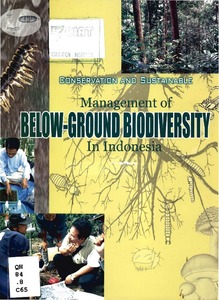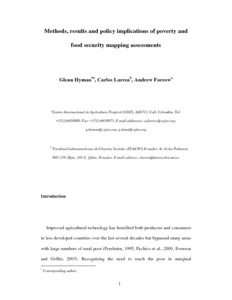Exploring the spatial variation of food poverty in Ecuador
We examine the geographic dimensions of food consumption in Ecuador, which has one of the highest rates of chronic infant undernutrition in Latin America. We use statistical and spatial analyses to examine the distribution of food consumption and food poverty and to test and generate hypotheses of food poverty estimates at the district level. Results show that the food poor are concentrated in certain locations with a significant cluster identified in the central Andean region.
Identifying areas for field conservation of forages in Latin American disturbed environments
This paper uses the spatial analysis tools DIVA and FloraMap to identify potential areas for the in situ conservation of a set of 10 forage species. We introduce the idea of roadside verges as conservation areas and discuss the risks and opportunities of two potential scenarios for conservation. These are the introduction of mass reservoirs outside of the original areas of collection and conservation inside the area of origin. Four potential areas for in situ conservation in Latin America are identified.
Integrated hydrological modelling of wetlands for environmental management: the case of the Usangu wetlands in the Great Ruaha catchment
Integrated hydrological modelling of wetlands for environmental management: the case of the Usangu wetlands in the Great Ruaha catchment
Knowledge of wetland hydrology and quantification of water inputs and outputs are Prerequisites to understanding wetland environments and determining their vulnerability to change. To get a better understanding of the dynamics of wetland change in the Usangu Plains, a study was conducted to: a) investigate the effects of human interventions on the wetlands, and b) determine the amount of dry season inflow required to maintain environmental flows downstream of the wetlands.
Methods, results and policy implications of poverty and food security mapping assessments
The importance of poverty reduction to the world development agenda has motivated greater interest in the geographic dimensions of poverty and food security. This special issue of Food Policy includes examples of poverty and food security mapping used to support policy development in agricultural and rural areas. The volume includes eight country case studies and one cross-country comparison that illustrate advances in our capacity to assess welfare over large areas and at detailed spatial resolutions.
Sistema georreferenciado de indicadores de calidad de suelos para los Llanos Orientales de Colombia : Estudio de caso: Municipio de Puerto López, Meta
Geosoil permite almacenar, consultar e interpretar información tanto del suelo como de su entorno biofísico a diferentes escalas: parcela, finca, comunidad, municipio, departamento, región, país. Opera a partir de una base de datos relacional elaborada en ACCES 2000, compuesta por una serie de tablas principales estructuradas con información a diferentes niveles jerárquicos que permiten la caracterización de las propiedades del suelo.
Very high resolution interpolated climate surfaces for global land areas
We developed interpolated climate surfaces for global land areas (excluding Antarctica) at a spatial resolution of 30 arc s (often referred to as 1-km spatial resolution). The climate elements considered were monthly precipitation and mean, minimum, and maximum temperature. Input data were gathered from a variety of sources and, where possible, were restricted to records from the 1950 2000 period. We used the thin-plate smoothing spline algorithm implemented in the ANUSPLIN package for interpolation, using latitude, longitude, and elevation as independent variables.
Evaluación ambiental del proceso de urbanización de las cuencas del piedemonte andino de Santiago de Chile
Las cuencas son complejos sistemas ambientales en que se desarrollan procesos geomorfológicos, hidrológicos, climáticos y ecológicos, que son impactados por la urbanización. En este trabajo se estudian seis cuencas del piedemonte andino de la ciudad de Santiago que se encuentran en diferentes fases del proceso de urbanización, variando entre Macul-San Ramón, en donde casi el 40% de su superficie ha sido incorporada a la ciudad, y Pirque, que mantiene aún sus características agrícolas y rurales.
ICARDA Annual Report 2004
In 2004, ICARDA began strategic visioning, driven by the global focus on achieving the Millennium Development Goals and the realignment of the CGIAR System priorities by the Science Council. It involved, among other actions, a consolidation of the 19 research projects into six mega-projects for better integration of the Center’s multidisciplinary teams, and an increased use of new tools of science in addressing the problems of poverty and degradation of natural resources.
Decision Support System (DSS) for sustainable watershed management in Dong Nai Watershed - Vietnam
In this study, DSS was developed using linear programming (LP), goal programming (GP), and geographic information system (GIS) for sustainable watershed management in Dong Nai watershed, Vietnam. A case study approach was undertaken using `what-if` planning scenarios. The multi-objective linear programming (MOLP) techniques and GIS have been applied to display the optimum land resource allocation in different scenario, in order to evaluate the sustainable strategy of land development in a watershed.







